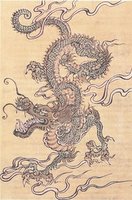Wednesday, September 27, 2006
The Dragon

“Can you draw out Leviathan with a fishhook or press down his tongue with a cord? … His sneezings flash forth light, and his eyes are like the eyelids of the dawn. Out of his mouth go flaming torches; sparks of fire leap forth. Out of his nostrils comes forth smoke, as from a boiling pot and burning rushes.” (Job 41:1, 18-20 ESV)
Recently, I have been talking with my Chinese friends about dragons. In Chinese culture the dragon is a sign of good luck. Many times the dragon is considered divine; therefore, early Chinese empires claimed to be dragons or related to a dragon. However, European dragons are considered malevolent. They are signs of treachery and destruction.
We came to realize that dragons or serpent-like creatures are found almost in every ancient culture. As seen above the Hebrews had the Leviathan; Canaanites had Lawtan (who Baal overcame); the Hittites had Illuyankas; the Sumerians and Babylonians had Tiamat; the Greeks had Ladon, Hydra, Python, Pythia, and Typhon; the Indians (from India) had Vyalee; the Siberians had Yilbegan; the Koreans had Yong, yo, and kyo; the Japanese had Ryu; and the Chinese had Lung.
I told my friends that it appears that ancient man had a common ancestry where the idea of the dragon originated. China and Canaan are rarely if ever connected in ancient times. But how could these two ancient civilizations created very similar concepts of the dragon if they did not have some early interaction?
Where did the idea of a dragon come from? I have two hypotheses: (1) the idea of the dragon is a mythological form of a dinosaur or (2) Adam and Eve told their descendants about the serpent in the Garden of Eden. You choose or come up with your own!
For further thought, think about the Phoenix appearing in both Chinese and Egyptian mythology.
Comments:
<< Home
Was this the Elder Wand you sought:
http://www.helsinki.fi/~pjojala/dinosaur.htm
?
Dinotopia is not a fiction. Dinoglyfs and dinolits are not only literally described but even carved, hewn and painted all over the continents by the paleolithic man and even by the man of antiquities.
E.g. Beowulf is the oldest book written in the archaic English that still survives. Guess what? Its main figure is yet another dragon slayer, this time from our Nordic countries.
Dinoglyfs they are. Ever read the book of Job? That's Leviathan & Behemot, folks. The longest description of any animals in the whole Jewish Grammata. Besides the flying reptiles of as late a figure as Isaiah - the flying snakes were described also by the Greek father of history, Herodotos.
In Mosaic law of the Old Testament of Judaism and Christianity, there was also one species classified as both bird and a reptile. What about if this
tinshemet=
Qetzalcoatl=
Archaeopteryx=
’old feather'
http://www.helsinki.fi/~pjojala/Tinshemet.htm
?
Recovering from hemorrhage in the left hemisphere of the brain,
Pauli.Ojala@gmail.com
evolutionary critic
Biochemist, drop-out
(MSci-Master of Sciing)
Helsinki, Finland
Post a Comment
http://www.helsinki.fi/~pjojala/dinosaur.htm
?
Dinotopia is not a fiction. Dinoglyfs and dinolits are not only literally described but even carved, hewn and painted all over the continents by the paleolithic man and even by the man of antiquities.
E.g. Beowulf is the oldest book written in the archaic English that still survives. Guess what? Its main figure is yet another dragon slayer, this time from our Nordic countries.
Dinoglyfs they are. Ever read the book of Job? That's Leviathan & Behemot, folks. The longest description of any animals in the whole Jewish Grammata. Besides the flying reptiles of as late a figure as Isaiah - the flying snakes were described also by the Greek father of history, Herodotos.
In Mosaic law of the Old Testament of Judaism and Christianity, there was also one species classified as both bird and a reptile. What about if this
tinshemet=
Qetzalcoatl=
Archaeopteryx=
’old feather'
http://www.helsinki.fi/~pjojala/Tinshemet.htm
?
Recovering from hemorrhage in the left hemisphere of the brain,
Pauli.Ojala@gmail.com
evolutionary critic
Biochemist, drop-out
(MSci-Master of Sciing)
Helsinki, Finland
<< Home

